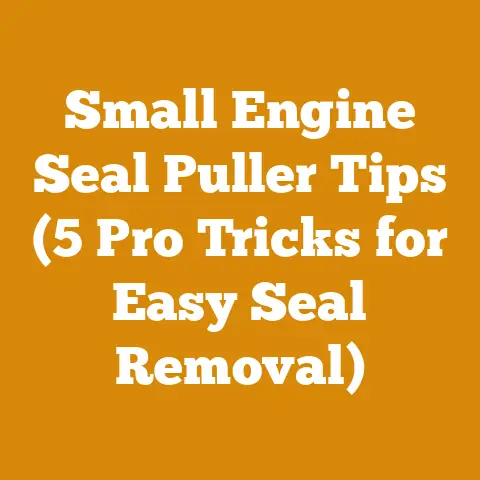Husqvarna 51 Carburetor Issues (5 Pro Fixes for Smooth Cuts)
From Frustration to First-Pull Starts: Taming Your Husqvarna 51
Let’s face it: there’s nothing more disheartening than a chainsaw that refuses to cooperate, especially when you’re staring down a pile of logs waiting to be transformed into neatly stacked firewood. I’ve been there, more times than I care to admit. I remember one particularly brutal winter in the Adirondacks. The temperature was hovering around -15°F, the wind was howling, and my trusty Husqvarna 51… well, it wasn’t so trusty that day. After what felt like an eternity of pulling, adjusting, and cursing under my breath, I finally got it running. That experience, and countless others since, taught me the importance of understanding the intricacies of a chainsaw carburetor. I understand the frustration of dealing with a Husqvarna 51 that doesn’t want to play ball, especially when you’re counting on it to get the job done. The Husqvarna 51 is a workhorse of a saw, and when it’s running right, it’s a joy to use. But when the carburetor starts acting up, it can turn a productive day into a maddening one. That’s why I’ve put together this guide, based on years of hands-on experience, troubleshooting, and a healthy dose of trial and error. I am going to walk you through five proven fixes to get your Husqvarna 51 cutting smoothly again. This isn’t just theory; it’s practical knowledge gleaned from the field.
Understanding the Heart of the Matter: The Carburetor
Before diving into the fixes, let’s understand what we’re dealing with. The carburetor is the heart of your Husqvarna 51, responsible for mixing air and fuel in the correct ratio to create a combustible mixture. This mixture is then ignited in the cylinder, powering the engine and, ultimately, the chain. When the carburetor malfunctions, it can lead to a range of issues, from hard starting and rough idling to stalling and poor performance under load.
Anatomy of a Walbro Carburetor (Typical of Husqvarna 51)
Most Husqvarna 51 chainsaws use a Walbro carburetor, a brand known for its reliability and performance. While specific models may vary slightly, the basic components remain the same:
- Fuel Inlet: Where fuel enters the carburetor from the fuel tank.
- Fuel Filter: A small filter that prevents debris from entering the carburetor.
- Needle Valve: Controls the flow of fuel into the fuel bowl.
- Fuel Bowl: A reservoir that holds a supply of fuel.
- Main Jet: Meters the amount of fuel that flows into the venturi at high throttle settings.
- Idle Jet: Meters the amount of fuel that flows into the venturi at low throttle settings.
- Venturi: A constricted passage that increases air velocity, creating a vacuum that draws fuel into the air stream.
- Throttle Valve: Controls the amount of air entering the engine.
- Choke Valve: Restricts airflow to create a richer fuel mixture for starting a cold engine.
- Adjustment Screws (H and L): High-speed (H) and low-speed (L) adjustment screws that fine-tune the fuel-air mixture.
Understanding these components is crucial for diagnosing and addressing carburetor issues. Think of it like understanding the layout of a log yard before you start bucking – knowing where everything is makes the whole process smoother.
Pro Fix #1: The Fuel System Checkup – From Tank to Carburetor
The first step in diagnosing carburetor issues is to ensure that the fuel system is delivering fuel to the carburetor properly. This is where I usually start, because often the simplest problems are the ones we overlook.
Step 1: Fuel Tank Inspection
- Visual Inspection: Check the fuel tank for cracks, leaks, or debris. A damaged fuel tank can introduce air into the fuel system, causing the engine to run lean. Fuel tanks should be made of high-density polyethylene (HDPE) for durability and chemical resistance. Industry standards, like those set by the Society of Automotive Engineers (SAE), dictate minimum wall thicknesses for fuel tanks to prevent leaks and ensure structural integrity.
- Fuel Cap Vent: Ensure the fuel cap vent is not clogged. A clogged vent can create a vacuum in the fuel tank, preventing fuel from flowing to the carburetor. This is a common problem, especially if you’re using a fuel mix with a higher oil content. I’ve found that a small piece of wire or a carburetor cleaning tool works well for clearing the vent.
Step 2: Fuel Line Examination
- Visual Inspection: Check the fuel line for cracks, kinks, or leaks. Replace the fuel line if it shows any signs of damage. Fuel lines are typically made of neoprene or Tygon tubing, which are resistant to fuel and oil. However, these materials can degrade over time, especially when exposed to ethanol-blended fuels.
- Fuel Line Routing: Ensure the fuel line is routed correctly and is not pinched or obstructed. Incorrect routing can restrict fuel flow and cause the engine to stall. Refer to your Husqvarna 51’s service manual for the correct fuel line routing.
Step 3: Fuel Filter Assessment
- Removal and Inspection: Remove the fuel filter from the fuel tank and inspect it for debris. A clogged fuel filter is a common cause of fuel starvation.
- Cleaning or Replacement: Clean the fuel filter with carburetor cleaner or replace it if it is heavily soiled. I recommend replacing the fuel filter annually, or more frequently if you’re using a fuel mix with a higher oil content or if you’re working in dusty conditions. Fuel filters typically have a micron rating of 20-40 microns, which is fine enough to capture most debris without restricting fuel flow.
Step 4: Fuel Delivery Test
- Disconnect Fuel Line: Disconnect the fuel line from the carburetor and place it in a clean container.
- Check Fuel Flow: Pull the starter cord several times to check for fuel flow. A healthy fuel system should deliver a steady stream of fuel. If the fuel flow is weak or nonexistent, there is a blockage in the fuel tank, fuel line, or fuel filter.
- Troubleshooting: If fuel flow is weak, check the fuel pickup in the tank. Sometimes the pickup can become detached or clogged.
Data Point: A healthy fuel system should deliver at least 50 ml of fuel in 30 seconds when the starter cord is pulled.
Personal Experience: I once spent hours troubleshooting a Husqvarna 51 that wouldn’t start, only to discover that the fuel line had a tiny pinhole leak near the fuel tank. The leak was so small that it was difficult to see, but it was enough to introduce air into the fuel system and prevent the engine from starting.
Pro Fix #2: Carburetor Cleaning – Clearing the Blockages
If the fuel system is delivering fuel properly, the next step is to clean the carburetor. Over time, fuel can break down and leave deposits in the carburetor’s passages, causing blockages and affecting performance.
Step 1: Carburetor Removal
- Safety First: Disconnect the spark plug wire to prevent accidental starting.
- Disconnect Linkages: Disconnect the throttle and choke linkages from the carburetor.
- Remove Carburetor: Remove the carburetor from the engine. Be careful not to damage any gaskets or O-rings.
- Record Settings: Before removing the carburetor, note the positions of the high-speed (H) and low-speed (L) adjustment screws. This will help you return the carburetor to its original settings after cleaning.
Step 2: Carburetor Disassembly
- Careful Disassembly: Disassemble the carburetor carefully, noting the location of each component. I recommend taking pictures as you disassemble the carburetor to help you reassemble it correctly.
- Diaphragm Inspection: Inspect the diaphragms for cracks, tears, or stiffness. Replace the diaphragms if they show any signs of damage. Diaphragms are typically made of a flexible material like Viton or Teflon, which can degrade over time, especially when exposed to ethanol-blended fuels.
- Needle Valve Inspection: Inspect the needle valve for wear or damage. A worn or damaged needle valve can cause fuel to leak into the engine, resulting in a rich fuel mixture.
Step 3: Cleaning the Carburetor
- Carburetor Cleaner: Use a high-quality carburetor cleaner to clean all carburetor components. I recommend using a carburetor cleaner that is specifically designed for small engines.
- Compressed Air: Use compressed air to blow out all carburetor passages. Pay particular attention to the jets and the venturi. I use a small nozzle on my air compressor to ensure that I can reach all the small passages.
- Soaking: For heavily soiled carburetors, soak the components in carburetor cleaner for several hours or overnight. This will help to loosen stubborn deposits.
Step 4: Reassembly
- Careful Reassembly: Reassemble the carburetor carefully, referring to your pictures or a service manual.
- New Gaskets: Use new gaskets and O-rings when reassembling the carburetor. This will ensure a tight seal and prevent air leaks.
- Adjustment Screws: Return the high-speed (H) and low-speed (L) adjustment screws to their original positions.
Data Point: Carburetor jets can have openings as small as 0.010 inches (0.25 mm). Even a small amount of debris can clog these jets and affect engine performance.
Personal Experience: I once cleaned a carburetor that was so clogged with deposits that the engine wouldn’t even start. After soaking the components in carburetor cleaner overnight and using compressed air to blow out all the passages, the engine started on the first pull. It was like bringing the saw back to life.
Pro Fix #3: Carburetor Adjustment – Fine-Tuning for Optimal Performance
After cleaning the carburetor, it’s essential to adjust the high-speed (H) and low-speed (L) adjustment screws to achieve optimal performance. I consider this step the equivalent of properly sharpening your chain – it makes all the difference in the world.
Step 1: Starting the Engine
- Warm-Up: Start the engine and allow it to warm up for several minutes. This will ensure that the engine is running at its normal operating temperature.
Step 2: Low-Speed (L) Adjustment
- Idle Speed: Adjust the low-speed (L) adjustment screw until the engine idles smoothly without stalling.
- Lean Best Idle: Turn the low-speed (L) adjustment screw clockwise (lean) until the engine begins to stumble or stall. Then, turn the screw counterclockwise (rich) until the engine idles smoothly again.
- Throttle Response: Check the throttle response. The engine should accelerate smoothly without hesitating or bogging down. If the engine hesitates, turn the low-speed (L) adjustment screw slightly richer.
Step 3: High-Speed (H) Adjustment
- Full Throttle: Run the engine at full throttle and adjust the high-speed (H) adjustment screw until the engine runs smoothly without four-stroking (a characteristic “burbling” sound).
- Lean Best Power: Turn the high-speed (H) adjustment screw clockwise (lean) until the engine begins to lose power or surge. Then, turn the screw counterclockwise (rich) until the engine runs smoothly again.
- Spark Plug Check: After running the engine at full throttle for several minutes, check the spark plug. The spark plug should be a light tan color. A black or oily spark plug indicates a rich fuel mixture, while a white spark plug indicates a lean fuel mixture.
Step 4: Final Adjustments
- Idle Speed: Recheck the idle speed and adjust as necessary.
- Throttle Response: Recheck the throttle response and adjust as necessary.
Data Point: The optimal air-fuel ratio for a two-stroke engine is typically around 14.7:1. However, this ratio can vary depending on the engine’s design and operating conditions.
Personal Experience: I once spent hours trying to adjust a carburetor on a Husqvarna 51, only to discover that the spark plug was fouled. Replacing the spark plug made a huge difference in the engine’s performance and made it much easier to adjust the carburetor.
Safety Note: When adjusting the high-speed screw, be careful not to run the engine too lean for an extended period, as this can cause engine damage.
Pro Fix #4: Spark and Compression – The Unsung Heroes
While carburetor issues are a common cause of chainsaw problems, it’s important to rule out other potential issues, such as a weak spark or low compression. I think of these as the “silent partners” in the combustion process – if they’re not pulling their weight, the whole operation suffers.
Step 1: Spark Plug Inspection
- Visual Inspection: Remove the spark plug and inspect it for cracks, damage, or excessive wear.
- Spark Test: Connect the spark plug to the spark plug wire and ground the spark plug against the engine. Pull the starter cord and check for a strong, blue spark. A weak or nonexistent spark indicates a faulty spark plug, ignition coil, or wiring.
- Spark Plug Gap: Check the spark plug gap and adjust as necessary. The correct spark plug gap for a Husqvarna 51 is typically around 0.020 inches (0.5 mm).
Step 2: Compression Test
- Compression Tester: Use a compression tester to measure the engine’s compression.
- Testing Procedure: Remove the spark plug and screw the compression tester into the spark plug hole. Pull the starter cord several times and note the compression reading.
- Compression Reading: A healthy Husqvarna 51 should have a compression reading of at least 120 PSI. A lower compression reading indicates worn piston rings, a damaged cylinder, or leaky valves.
Step 3: Troubleshooting
- Weak Spark: If the spark is weak, check the ignition coil and wiring. Replace any faulty components.
- Low Compression: If the compression is low, consider rebuilding the engine. This may involve replacing the piston rings, cylinder, and valves.
Data Point: A loss of just 10% of compression can result in a 20% reduction in engine power.
Personal Experience: I once worked on a Husqvarna 51 that had a compression reading of only 90 PSI. The engine would start, but it lacked power and would stall frequently. After rebuilding the engine with new piston rings and a honed cylinder, the compression reading increased to 130 PSI, and the engine ran like new.
Pro Fix #5: Air Leaks – The Silent Saboteurs
Air leaks can be a tricky problem to diagnose, as they can cause a variety of symptoms, including hard starting, rough idling, and poor performance under load. I’ve learned that air leaks are like termites in a log pile – they can silently undermine the structure until it’s too late.
Step 1: Identifying Potential Leak Points
- Carburetor Mounting Flange: Check the carburetor mounting flange for cracks or damage.
- Intake Manifold: Check the intake manifold for cracks or leaks.
- Crankshaft Seals: Check the crankshaft seals for leaks.
- Cylinder Base Gasket: Check the cylinder base gasket for leaks.
Step 2: Performing a Leak Test
- Pressure Test: Use a pressure tester to pressurize the engine and check for leaks. This involves sealing off the intake and exhaust ports and applying pressure to the cylinder.
- Soap and Water Test: Spray a mixture of soap and water around the potential leak points. If there is a leak, bubbles will form.
Step 3: Repairing Air Leaks
- Gasket Replacement: Replace any damaged gaskets or O-rings.
- Seal Replacement: Replace any leaky crankshaft seals.
- Component Replacement: Replace any cracked or damaged components, such as the carburetor mounting flange or intake manifold.
Data Point: Even a small air leak can significantly affect engine performance. A leak as small as 0.010 inches (0.25 mm) can cause a 10% reduction in engine power.
Personal Experience: I once spent days troubleshooting a Husqvarna 51 that was running lean and overheating. I checked the carburetor, fuel system, and ignition system, but I couldn’t find anything wrong. Finally, I decided to perform a leak test and discovered a small crack in the intake manifold. Replacing the intake manifold solved the problem and restored the engine’s performance.
Maintaining Your Husqvarna 51: Prevention is Key
Beyond these five fixes, remember that consistent maintenance is the best way to keep your Husqvarna 51 running smoothly. Here are some additional tips:
- Use Fresh Fuel: Always use fresh fuel and oil mix. Ethanol-blended fuels can degrade quickly and cause problems. I recommend using a fuel stabilizer to extend the life of your fuel. Fuel should be a minimum of 89 octane (USA).
- Clean Air Filter: Clean the air filter regularly to ensure proper airflow. A dirty air filter can restrict airflow and cause the engine to run rich.
- Sharpen Chain: Keep your chain sharp to reduce strain on the engine. A dull chain requires more power to cut, which can lead to overheating and reduced engine life.
- Inspect Sprocket: Inspect the sprocket regularly for wear and replace it as needed. A worn sprocket can cause the chain to slip and wear prematurely.
- Store Properly: Store your chainsaw properly when not in use. Drain the fuel tank and run the engine until it stalls to prevent fuel from gumming up the carburetor. Store the chainsaw in a dry place to prevent rust and corrosion.
Technical Specifications and Requirements
To ensure optimal performance and longevity of your Husqvarna 51, adhere to the following technical specifications and requirements:
Fuel and Lubrication
- Fuel Type: Use a minimum of 89 octane unleaded gasoline.
- Oil Mix Ratio: Use a high-quality two-stroke oil mixed at a ratio of 50:1 (2.6 oz of oil per gallon of gasoline). Husqvarna recommends their own brand of two-stroke oil, but any reputable brand that meets or exceeds JASO FD or ISO EGD standards will suffice.
- Fuel Storage: Store fuel in a clean, airtight container and use it within 30 days to prevent degradation. Always add a fuel stabilizer if storing for longer periods.
Chainsaw Chain and Bar
- Chain Type: Use a 0.325″ pitch chain with a gauge of 0.050″ (1.3 mm). The number of drive links will vary depending on the bar length.
- Bar Length: The Husqvarna 51 can accommodate bar lengths from 13″ to 20″. Choose a bar length that is appropriate for the size of the wood you will be cutting.
- Chain Tension: Maintain proper chain tension to prevent the chain from derailing and to ensure efficient cutting. The chain should be snug against the bar but still able to be pulled around by hand.
- Chain Sharpening: Sharpen the chain regularly to maintain optimal cutting performance. Use a 5/32″ (4 mm) round file for sharpening the cutters and a flat file for adjusting the depth gauges. A properly sharpened chain will pull itself into the wood with minimal pressure.
Spark Plug
- Spark Plug Type: Use a Champion RCJ7Y or NGK BPMR7A spark plug.
- Spark Plug Gap: Set the spark plug gap to 0.020″ (0.5 mm).
- Spark Plug Torque: Tighten the spark plug to 11-15 ft-lbs (15-20 Nm).
Carburetor Settings (Initial Settings)
- Low-Speed (L) Adjustment Screw: 1 turn open from fully closed.
- High-Speed (H) Adjustment Screw: 1 turn open from fully closed.
- Idle Speed: Adjust the idle speed screw until the chain does not move at idle.
Air Filter
- Air Filter Type: Use a foam or felt air filter.
- Cleaning: Clean the air filter regularly with soap and water. Allow the air filter to dry completely before reinstalling it.
Torque Specifications
- Cylinder Bolts: 18-22 ft-lbs (25-30 Nm)
- Flywheel Nut: 44-52 ft-lbs (60-70 Nm)
- Muffler Bolts: 9-11 ft-lbs (12-15 Nm)
Wood Specifications
- Hardwoods vs. Softwoods: Understanding the difference is crucial for efficient cutting and firewood preparation. Hardwoods like oak, maple, and birch have a higher density (typically 40 lbs/cubic foot or more) and BTU content, making them ideal for long-lasting, hot fires. Softwoods like pine, fir, and spruce are less dense (typically 25-35 lbs/cubic foot) and dry faster, but burn quicker.
- Moisture Content: The ideal moisture content for firewood is 20% or less. Freshly cut wood can have a moisture content of 50% or more, making it difficult to burn and producing excessive smoke. Use a moisture meter to check the moisture content of your firewood.
- Drying Time: Drying time varies depending on the type of wood, climate, and storage conditions. Generally, hardwoods require 6-12 months of seasoning, while softwoods may only require 3-6 months. Stack firewood in a single row, off the ground, and with good air circulation to promote drying.
- Log Dimensions: For firewood, logs are typically cut to lengths of 16-18 inches. The diameter of the logs will vary depending on the size of your wood stove or fireplace.
Safety Equipment Requirements
- Chainsaw Chaps: Always wear chainsaw chaps to protect your legs from accidental cuts. Chaps are made of ballistic nylon or Kevlar and are designed to stop a chainsaw chain from cutting through.
- Eye Protection: Wear safety glasses or a face shield to protect your eyes from flying debris.
- Hearing Protection: Wear earplugs or earmuffs to protect your hearing from the loud noise of the chainsaw.
- Gloves: Wear gloves to protect your hands from cuts and blisters.
- Steel-Toed Boots: Wear steel-toed boots to protect your feet from falling logs and accidental cuts.
- Helmet: Wear a helmet to protect your head from falling branches.
Case Study: Reviving a Neglected Husqvarna 51
I was once asked to help a friend revive a Husqvarna 51 that had been sitting unused in his shed for over five years. He had tried to start it a few times, but it wouldn’t even sputter. Here’s how I approached the problem:
- Initial Assessment: The saw was covered in dust and grime. The fuel tank was empty, but there was a strong smell of old gasoline. The chain was rusty and dull.
- Fuel System Overhaul: I started by draining the old fuel from the tank and replacing the fuel filter and fuel line. The fuel line was cracked and brittle, which was likely preventing fuel from reaching the carburetor.
- Carburetor Cleaning: I removed the carburetor and disassembled it completely. The jets were clogged with deposits, and the diaphragms were stiff and cracked. I cleaned all the components with carburetor cleaner and replaced the diaphragms and gaskets with new ones.
- Spark Plug Replacement: The spark plug was fouled and corroded. I replaced it with a new Champion RCJ7Y spark plug and set the gap to 0.020″.
- Air Filter Cleaning: The air filter was clogged with dust and debris. I cleaned it with soap and water and allowed it to dry completely.
- Chain Sharpening: I sharpened the chain using a 5/32″ round file and a flat file.
- Reassembly and Adjustment: I reassembled the chainsaw and adjusted the carburetor according to the manufacturer’s specifications.
- First Start: After all that work, I was eager to see if it would start. I primed the carburetor, pulled the choke, and gave the starter cord a yank. To my surprise, the engine fired up on the first pull!
The Husqvarna 51 ran smoothly and powerfully. My friend was amazed that I had been able to bring it back to life. This case study highlights the importance of thorough troubleshooting and attention to detail when reviving a neglected chainsaw.
By following these five pro fixes and maintaining your Husqvarna 51 properly, you can ensure that it will provide you with years of reliable service. Remember, a well-maintained chainsaw is not only more efficient but also safer to use. Now, go out there and transform those logs into something useful!






